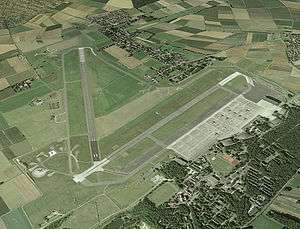Wunstorf Air Base
Wunstorf Air Base.svg.png) RAF Wunstorf Advanced Landing Ground (ALG) B-116 | |
|---|---|
|
Aerial picture prior to 2010's expansion | |
| Coordinates | 52°27′17″N 009°25′44″E / 52.45472°N 9.42889°E |
| Type | Military Airfield |
| Site information | |
| Controlled by |
|
| Site history | |
| In use | 1936-Present |
| Battles/wars | World War II |
| Garrison information | |
| Occupants |
|
| Airfield information | |||||||||||||||||||
|---|---|---|---|---|---|---|---|---|---|---|---|---|---|---|---|---|---|---|---|
| IATA: none – ICAO: ETNW | |||||||||||||||||||
| Summary | |||||||||||||||||||
| Elevation AMSL | 187 ft / 57 m | ||||||||||||||||||
| Coordinates | 52°27′17″N 009°25′44″E / 52.45472°N 9.42889°ECoordinates: 52°27′17″N 009°25′44″E / 52.45472°N 9.42889°E | ||||||||||||||||||
| Map | |||||||||||||||||||
 ETNW Location of Wunstorf Air Base | |||||||||||||||||||
| Runways | |||||||||||||||||||
| |||||||||||||||||||

Wunstorf Air Base is a German Air Force military airfield (air base), located 6 km south-southwest of Neustadt am Rübenberge or 4 km north-northwest of Wunstorf in Lower Saxony, Germany. Wunstorf Air Base is the home to Air Transport Wing 62 (Lufttransportgeschwader 62), the unit to operate all German Airbus A400M Atlas.
History
The airfield was originally opened in 1936 for the National Socialist Luftwaffe. During the Second World War, it was seized by the British Army on 7 April 1945, in a fierce battle by elements of the 5th Parachute Brigade, 6th Airborne Division. During the battle, in which the 13th Battalion was also engaged, the 7th (Light Infantry) Parachute Battalion lost 6 killed, and 21 wounded, most from the initial ambush of the four leading trucks of B Company. The airfield was captured with 19 Me 109s, 4 Fw 190s, 2 Ju 88s, 2 Ju 52s and much other valuable equipment.
After the battle, the base was taken over by the Royal Air Force, including Canadian (R.C.A.F.) Wing 126 of the British 2nd Tactical Air Force, and designated as Advanced Landing Ground B-116 Wunstorf.
The airfield features heavily in the book "13 - Lucky For Some" which is about the history of the 13th (Lancashire) Parachute Battalion. There are many then and now photographs as well as maps and diagrams of battles that took place in the region.
It was later designated RAF Station Wunstorf and used by Royal Air Force Germany. RAF units assigned were:
- 1947-1950: 2 Sq with Spitfire F 14/PR 19
- 1950-1952: 4 Sq, 26 Sq with Vampire FB 5
- 1950-1955: 11 Sq with Vampire FB 5, later Venom FB 1, later FB 4
- 1952-1955: 5 Sq with Vampire FB 5, later Venom FB 1
- 1952-1955: 266 Sq with Vampire FB 5, later FB 9, later Venom FB 1
- 1954: 4 Sq
- 1954: 93 Sq
- 1955-1956: 79 Sq with Meteor FR 9
- 1955-1957: 541 Sq with Meteor PR 10
- 1956-1957: 5 Sq, 11 Sq, 266 Sq with Venom FB 4
In 1957 the airfield returned to the control of the German Air Force and became a NATO Air Base.
Use by German Air Force
German Air Force first stationed Nord Noratlas which by 1971 were replaced by C-160D Transall; those were disbanded from the local LTG62 in July 2015, now focussing on accepting and integrating Airbus A400M Atlas. Flight training for decades was executed using Dornier Do 28.
Expansion in 2010's
As preparation for 40 Airbus A400M Atlas to be stationed at Wunstorf Air Base, the airbase underwent (and as of February 2016 still undergoes) major expansion. Runway 08/26 was lengthened from 1,877 m to 2,499 m (45 m wide) mainly to the east. Parking positions were expanded, one maintenance hangar has been erected, another one is under construction. A building to house the flight simulator has been added.
References
- World Aero Data Wunstorf
- Military Airfield Directory Wunstorf Airbase
- Wunstorf and Neustadt April 1945
- Johnson, David C. (1988), U.S. Army Air Forces Continental Airfields (ETO), D-Day to V-E Day; Research Division, USAF Historical Research Center, Maxwell AFB, Alabama.
External links
| Wikimedia Commons has media related to Wunstorf Air Base. |
- Airport information for ETNW at Great Circle Mapper.
- Airport information for ETNW at World Aero Data. Data current as of October 2006.
